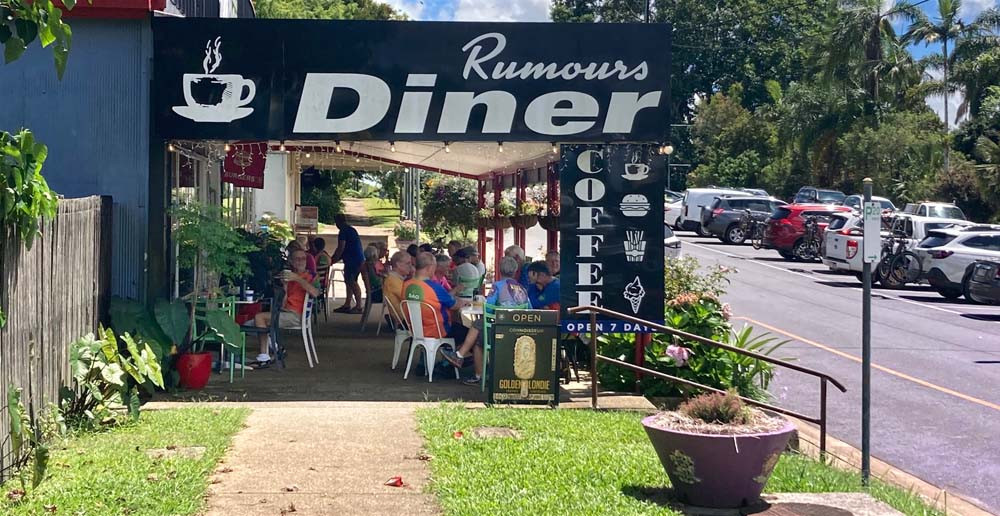Community & Business
21 February, 2024
Traders slow to recover after highway closure
VEHICLES are again flowing along the Palmerston Highway after it finally opened to traffic 10 days ago, but local businesses will have to wait a lot longer to recover losses in trade suffered during its two-month closure.

The highway suffered significant damage during December’s extreme rainfall, dropping the road surface by two metres, cracking the surface wide open and rocks and debris dumped onto the highway from numerous landslides.
Crews from the Department of Transport and Main Roads (TMR) worked at top pace to get the highway opened earlier than expected on 10 February, but businesses in Millaa Millaa particularly are reeling from the absence of customers.
Some businesses like Barista in the Mist Café and Rumours Café have been fortunate to have had special visits from groups such as the Cairns Power Cruise Club, and the Tablelands Sixty and Over Cycling group who did two rides with around 40 people taking part to support Millaa Millaa.
Mac Whitaker, a local born and bred Millaa boy, organised the rides because the closure was having such an adverse impact on the town.
“It’s a great way to show our support and bring a bit of business to the town,” he said.
Millaa Millaa Hotel publicans Bruce and Theresa Olive say they had a 30% decrease in business during the closure of the Palmerston Highway.
“We had very few visitors coming through,” Theresa said.
Mungalli Creek Dairy public relations representative Michelle Bell-Turner said the closure of the Palmerston Highway was like turning off the lifeblood for the southern Tablelands.
“This gateway being closed had a significant impact for both tourism, agriculture and local visitation and spend in the region, impacting our business and many others in the region,” Michelle said.
“As a dairy farm manufacturer, we transport 100 pallets of finished dairy product a week and all this normally goes via the Palmerston.
“To still maintain supply of product we had to pay freight surcharges of $6,000 per month to enable supply to still go to Townsville.
“We also have our own farm café and to not have that route available for customers to visit significantly impacted visitation and sales during December and January.
“We are very grateful that the Palmerston has reopened and the change in visitation to our café is noticeable since it’s reopening.
“The increased costs and loss of sales from December and January equated to close to $250,000 for our business.”
It wasn’t only retail businesses that suffered from the closure, with farmers forced to fork out extra for freight costs, reportedly paying $30 extra per pallet of produce on average, equating to about $1500 in additional charges per truckload.
For Member for Kennedy Bob Katter, that’s another good reason why a new freight route less prone to closures should be constructed from the Tablelands to the coast.
“The message was pretty clear on the ground though, business owners, residents and farmers are all sick of these highways which traverse rainforest and close multiple times a year,” he said.
“It’s time for the tunnel. When there’s a traffic problem in Brisbane, straight away we see a new road or a tunnel. Where’s North Queensland’s tunnel?
“We need the Bridle Track Tunnel now – connecting Mareeba to southern Cairns with a travel time less than 30 minutes.
“That's where our producers, both agriculture and minerals should be sending their heavy freight. Not down our beautiful rainforest drives which close every week."
Meanwhile, TMR has rejected any suggestion that the transportation of heavy wind turbines last year may have contributed to the damage caused to the Palmerston Highway.
“The heavy rainfall following the cyclone disturbed the natural stability of the slope approaching the Palmerston Highway due to the proximity of Henrietta Creek, which is adjacent to the road corridor,” a TMR spokesperson said.
“The saturated soil caused this section of the highway to become unstable.”
TMR says relevant permits were sought and obtained from the National Heavy Vehicle Regulator (NHVR) to transport the wind turbines up the range.
“TMR’s experienced engineering teams and technical experts are asked to conduct a number of pre-trip assessments, including geometric assessments (vehicle turning), pavement assessments (to ensure the road surface is sufficient to take heavy loads), and structural assessments (travelling across bridges and other structures),” the spokesperson said.
“These assessments were completed by our teams of engineering and technical experts and no issues were identified.”



